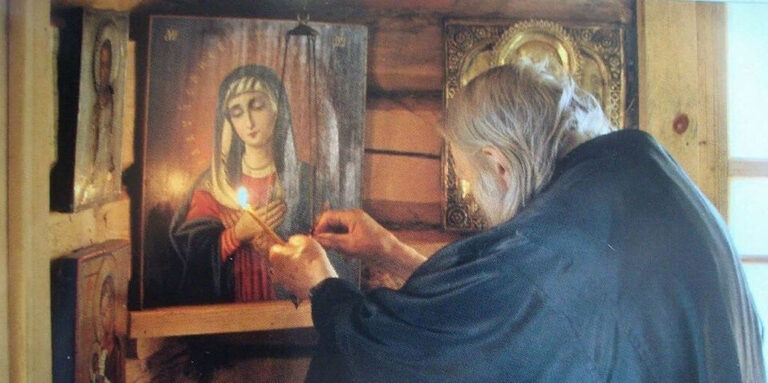The veneration of Mary is inscribed in the very depths of the human heart.
—Martin Luther
The following prayer, from the Supplicatory Canon to the Most Holy Theotokos (which is included in the Jordanville prayer book), has been making the rounds in Protestant social media circles:
0 my most blessed Queen, 0 Theotokos my hope, guardian of orphans, intercessor for strangers, joy of the sorrowful, protectress of the wronged: thou seest my misfortune, thou seest mine affliction; help me, for I am weak; feed me, for I am a stranger. Thou knowest mine offence: absolve it as thou wilt, for I have no other help beside thee, no other intercessor, nor good consoler, except thee, 0 Mother of God. Do thou preserve and protect me unto the ages of ages. Amen.
One particular Protestant, who initially confused Orthodox Christians with “Romanists,” cited this as evidence that both are guilty of idolizing Mary. Unfortunately, many Protestants, so accustomed to reading texts literally, are unfamiliar with the effusive language that the early Church (and even early Protestant reformers) used in reference to the Mother of God. I asked him if it was his view that we Orthodox Christians literally believe that Mary is our only helper, intercessor or consoler. Of course, I am not surprised that he refused to directly answer this question. After all, Protestants also frequently chastise us for seeking the intercessions of other saints. Indeed, guided by that very prayer book, the Orthodox Christian refers to his patron saint as “the speedy helper and intercessor” for his soul (p. 27). He also calls on God, not just Mary, to be his “soul’s helper” (p. 58). Likewise, he quotes the Psalmist in saying, “Thou, O God, are my helper” (p. 72). How on earth did the “Mary worshipers” who put together this prayer book miss these “inconsistencies”?
Or what about the fact that, in one of our canons, we “flee only to” our guardian angel, but elsewhere say that we flee to Jesus (p. 224), Mary (p. 236), and all the “Angels, Archangels, and… The Heavenly Host and Our Modern LifeThis celebration has great significance not only for Orthodox Christians, but for all of mankind. How is that?
The Heavenly Host and Our Modern LifeThis celebration has great significance not only for Orthodox Christians, but for all of mankind. How is that?
“>heavenly hosts” (p. 328)? Oh, the contradictions! Let us pray that that the Mariolatrous and angelolatrous compilers of the Jordanville prayer book correct these “errors” in a future edition.
Sarcasm aside, if Protestants are willing to admit that these prayers are not to be interpreted literally—if they acknowledge that our sacred texts should not be read as legal codes—then they will have a more difficult time accusing us of idolatry, especially since the prayer book they condemn leaves no room for doubt as to who our true God is (consider, for instance, the daily-recited Nicene-Constantinopolitan Creed, which affirms our belief in the Triune God: p. 14). If they reflected upon both our desperate spiritual condition and Mary’s “highly favored” status (Luke 1:28), then they might begin to understand how such reverential language could flow naturally from one’s hearts during prayer. Let us recall that the ground on which Moses stood was so holy that he was told to remove his sandals (Exodus 3:5). Should we not also display special reverence for the holy vessel through which God became man?
I put another question to the Protestant: At what point did Early Christians cross the line into Mariolatry? This, too, he failed to answer. Perhaps he knew that Mary—the “holy Virgin” (Aristides of Athens, 125 AD), the new Eve (St. Justin Martyr, 155 AD), the “fair ewe” (St. Melito, 170 AD), the “cause of salvation” for “the whole human race” (St. Irenaeus, 185 AD)—was revered very early on in Church history. It is worth mentioning that the last of these cited saints was a disciple of St. Polycarp of Smyrna, who in turn was a disciple of St. John the Apostle. It seems laughable that the Church could have fallen into idolatry in just three generations! That issue aside, there is little to no documented controversy over Marian veneration in early Christian history. I find no records of early Christians objecting to the reverence expressed in the oldest liturgy still in use (i.e., the Liturgy of St. James, which is believed to have been composed as early as 370 AD) in which we commemorate “the holy and just, our all-holy, pure, most glorious Lady, the God-mother, and ever-virgin Mary.” I see no one protesting the Church’s earliest known hymn to Mary (“Beneath Thy Compassion”, C.A. 250 AD) where we sing the following.
Seeking refuge under your mercy, O Mother of God, we humbly ask for your intercession in times of necessity. Please do not ignore our pleas, but protect us from harm, O immaculate and blessed one.
In considering the infallibility of the Church, known as “the pillar and foundation of the truth” (1 Tim 3:15), it is important to address when errors may have occurred.
Reflecting on a conversation with a Protestant who challenged the honor given to Mary by citing fallibility among the early Church Fathers, it is necessary to evaluate the Protestant doctrine of sola scriptura. This doctrine asserts that Scripture alone is authoritative for faith and practice.
While it is true that the Fathers, like the Apostles, had disagreements at times, the Church has historically resolved such disputes through ecumenical councils. These councils, embraced by the faithful, affirmed the veneration of Mary as the Mother of God. It is essential to recognize that true authority comes from personal beings, and the Church, as the Body of God, is the ultimate authority.
Just as the Holy Spirit guided the fallible Apostles in writing infallible Scriptures, we believe that the Spirit inspired the elevated language used to honor the Mother of God, who is integral to our salvation.
Source link

